Heinrich Heine "Shakespeares Mädchen und Frauen"
Heinrich Heine, Shakespeares Mädchen und Frauen (1838)
In 1838, the French publisher Deloye, Désiré & Cie was looking for a well-known writer to produce a commentary for a series of engravings that had originally been created for Charles Heath’s The Shakespeare Gallery and featured portraits of fashionable, idealised female characters from Shakespeare’s plays. As Shakespeare’s Frauenbilder, the book had also been published for the German market. It is representative of the increasingly character-centred approach to Shakespeare that dominated the nineteenth century. Prominent actresses and actors were often closely associated with the Shakespearean roles they embodied on stage, and numerous books developed background narratives for the dramatis personae. Shakespeare’s heroines were a particularly popular subject, as for example in Anna Jameson’s Characteristics of Women (1836) or Mary Gordon Clarke’s The Girlhood of Shakespeare’s Heroines (1850/51).
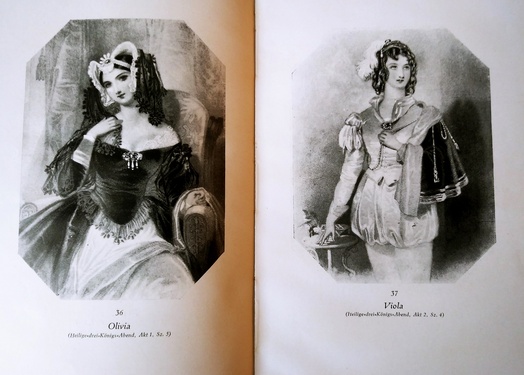
Two illustrations of Olivia and Viola in Shakespeares Mädchen und Frauen
The task eventually fell to the German poet, satirist, journalist, and essayist Heinrich Heine (1797–1856). Heine had made a name for himself with a first volume of travel reports (Reisebilder I, 1826) as well as a volume of collected poems (Buch der Lieder, 1827), but faced increasing restrictions due to the censorship that was imposed on all German publications in the Carlsbad Decrees of 1819. In his characteristic satirical tone, Heine often criticised official institutions and the monarchy. As a result, his texts were not only censored, but eventually completely banned in the German Confederation, which effectively made it impossible for him to earn a livelihood. He therefore left the German Confederation in the early 1830s to work as freelance journalist in Paris. The French publisher’s plan for a commented and illustrated volume on Shakespeare’s female characters, for him, was a welcome opportunity not just to earn money, but to publish for a German audience as the title and topic of the book would not automatically seem suspicious to the German authorities.
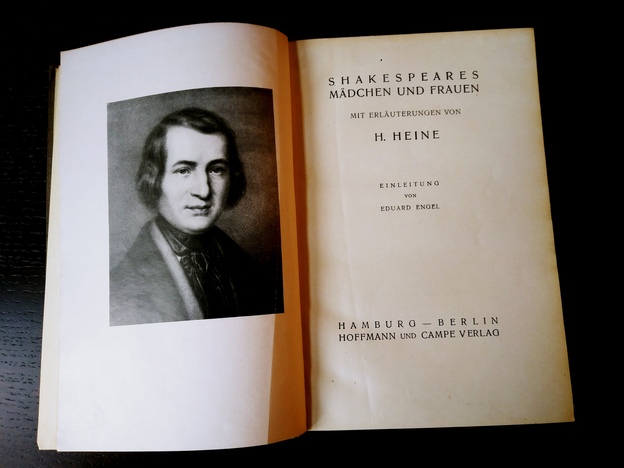
Frontispiece and title page of a 1925 reprint of Heine's Shakespeares Mädchen und Frauen
Heine accepted the publisher’s proposal of 4000 Francs and wrote a commentary during the summer of 1838. Heine probably came across Schlegel’s and Tieck’s Shakespeare translation while he studied in Bonn and attended Schlegel’s lectures in 1819. Moreover, an extended journey to England in the spring and summer of 1827 gave him the chance to visit the London Theatre Royal, Drury Lane, and to see the actor Edmund Kean as Othello, Shylock, Richard III, and Macbeth, with whose acting he was very impressed.
Despite the seemingly apolitical format, Heine uses Shakespeares Mädchen und Frauen to make the sort of critical statements that had led the German authorities to ban his publications. His comments on Jessica and Portia in The Merchant of Venice are a case in point. They address the antisemitism which he himself, as the son of an old German Jewish family, was faced with throughout his life. But for Heine, Shakespeare’s play is not only about a conflict between Jews and Christians. Instead, The Merchant of Venice reveals Shakespeare’s deep understanding of human nature. Heine writes:
“der Genius des Shakespeare erhebt sich noch über den Kleinhader zweier Glaubensparteien, und sein Drama zeigt uns eigentlich weder Juden noch Christen, sondern Unterdrücker und Unterdrückte, und das wahnsinnig-schmerzliche Aufjauchzen dieser letztern, wenn sie ihren übermütigen Quälern die zugefügten Kränkungen mit Zinsen zurückzahlen können” [“The genius of Shakespeare rises still higher over the petty strife of two religious sects, and his drama shows us neither Jews nor Christians, but oppressor and oppressed, and the madly agonised cries of exultation of the latter when they can repay their arrears of injuries with interest“].
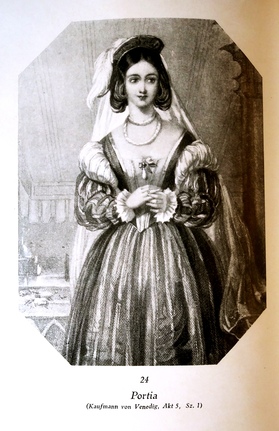
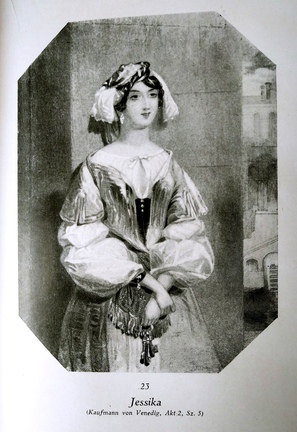
Two illustrations of Portia and Jessica in Shakespeares Mädchen und Frauen
In the context of the revolutionary movements of the 1830s and 40s, the political implications of statements like these would have been immediately obvious. Shakespeares Mädchen und Frauen is a good example of how Shakespeare and politics often intersect even in the unlikeliest places, or, in this case, genres. Heine uses what is effectively a coffee table book avant la lettre to convey political messages that had rendered him persona non grata in his country of birth.
Both Heath’s The Shakespeare Gallery and Heine’s Shakespeares Mädchen und Frauen are still in print at the point of writing. Heine’s commentary is now sometimes published without the engravings that originally gave rise to it, and has even been translated into English. Originally undertaken “unwillingly and while I was sick” (as Heine wrote to Campe, his Hamburg publisher in 1838), it has become part of the canon of European Shakespeare criticism.
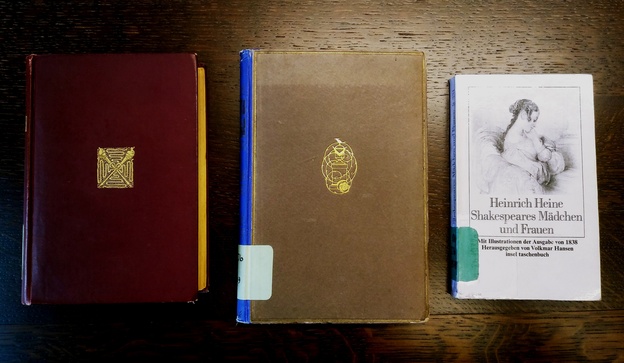
Three different editions of Heine's Shakespeares Mädchen und Frauen in the Munich Shakespeare Library

